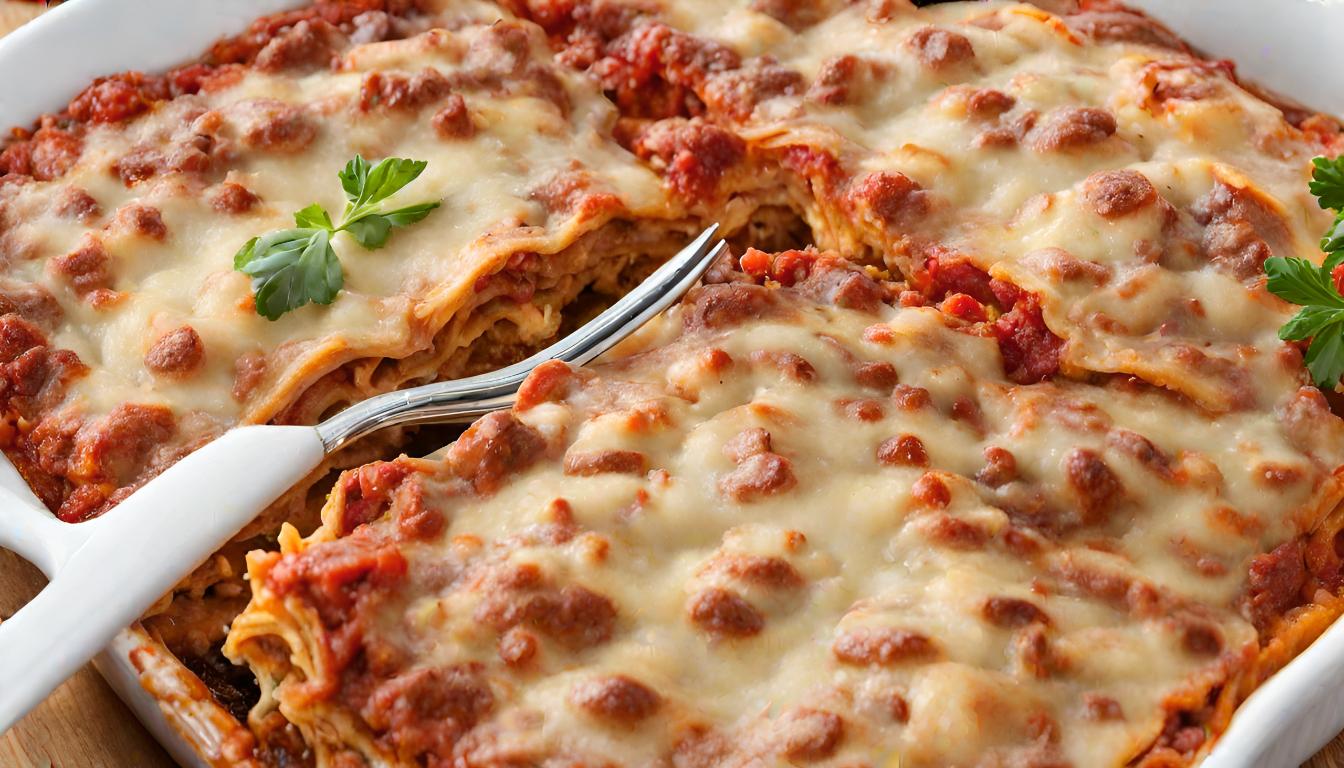Lasagna, a dish as rich in history as it is in flavor, has long been a staple in kitchens worldwide. From its ancient origins to its modern-day variations, lasagna has evolved into a culinary symbol of comfort and versatility. But amidst the layers of cheese, sauce, and pasta, a question often arises: How many layers is best for lasagna? This article delves into the art of lasagna layering, exploring everything from the dish’s historical roots to practical tips for crafting the perfect lasagna. Whether you’re a seasoned chef or a curious home cook, this comprehensive guide will unveil the secrets to achieving that ideal lasagna balance.
Introduction to Lasagna :
Understanding Lasagna’s Rich History and Popularity
Lasagna, oh lasagna! A dish that has tantalized taste buds for centuries, weaving a rich tapestry through culinary history. Its journey began with the early Etruscans, as suggested by archeological evidence. Imagine, if you will, a time when ancient hands layered pasta in a manner not so different from ours today. The oldest surviving cookbook of the West, “Apicius’s De Re Coquinaria,” even boasts a recipe for this layered pasta casserole.
Fast forward to the present, and lasagna has become a beloved icon in kitchens far beyond its Italian roots. It’s a dish that has seamlessly integrated into various cultures, becoming the second most popular Italian dish, trailing only behind the universally adored garlic bread, according to a YouGov poll. But what truly makes lasagna stand out is its adaptability and the personal touch each cook brings to their creation.
The Origins and Evolution of Lasagna
Tracing the origins of lasagna is like flipping through the pages of a historical cookbook. Each era adds its own twist, transforming lasagna into the multifaceted dish we know today. From the simple layers of the past to the rich and diverse variations now found around the globe, lasagna’s evolution is a testament to its enduring appeal.
Lasagna in Modern Cuisine
In today’s culinary landscape, lasagna is more than just a dish; it’s a canvas for creativity. Modern interpretations see a fusion of traditional and contemporary flavors, catering to a wide array of tastes and dietary preferences. Whether it’s the classic ricotta and Bolognese sauce or innovative combinations like béchamel and porcini mushrooms, lasagna continues to reinvent itself, always maintaining its status as a crowd-pleaser.
In the next part, we’ll dive into the heart of lasagna making – the art of layering. How many layers strike the perfect balance between too thin and overly hefty? Stay tuned as we explore the key factors that guide this delicious dilemma.
Lasagna Variations and Techniques:
Exploring Different Lasagna Styles
Lasagna is like a culinary chameleon, adapting to different tastes and traditions. Across regions, you’ll find a kaleidoscope of styles, each with its unique charm. In Italy, variations range from the meat-heavy Lasagna alla Bolognese to the lighter Lasagna al Pesto, hailing from the north. But the journey doesn’t stop in Italy. Globally, lasagna has taken on local flavors, from the spicy layers of a Mexican-inspired lasagna to the earthy tones of a mushroom and spinach vegetarian option.
Regional Variations of Lasagna
Each region adds its twist to this classic dish, reflecting local ingredients and culinary traditions. In some areas, béchamel sauce is king, while in others, ricotta reigns supreme. The type of meat, the choice of vegetables, and even the kind of cheese can vary, offering a lasagna experience that’s as diverse as the regions themselves.
Vegetarian and Meat-Based Lasagnas
The versatility of lasagna extends to accommodating various dietary preferences. Meat lovers can revel in layers packed with beef, pork, or chicken, while vegetarians can enjoy a bounty of vegetables and cheeses. The beauty of lasagna is its ability to be reinvented, ensuring that no one misses out on this comforting dish.
Innovative Layering Techniques
Beyond the traditional layering, there’s a world of innovation waiting to be explored. Think outside the box with layers of polenta or eggplant for a gluten-free twist, or add a layer of creamy mashed potatoes for a heartier dish. The possibilities are endless, limited only by your imagination and palate.
Creative Ingredient Layering
Layering lasagna is an opportunity to get creative. Alternate between different types of cheeses, play with various sauces, or introduce unexpected ingredients like artichokes or truffle oil. Each layer is a new chapter in the story of your lasagna, each ingredient a character that adds depth and complexity.
Tips for Structurally Sound Lasagna
A great lasagna isn’t just about taste; it’s also about structure. To avoid a lasagna collapse, start with a solid foundation – a layer of sauce on the bottom. This not only prevents sticking but also sets the stage for the layers to come. Be mindful of moisture content; too much liquid can lead to a lasagna landslide. And remember, patience is key – let your lasagna rest a bit after baking to ensure it holds its shape when served.
In the next part, we’ll dive into practical tips and tricks for perfecting your lasagna layers, from selecting the right ingredients to mastering the assembly process. Stay tuned for these essential lasagna-making insights!
Practical Tips and Tricks:
Essential Tips for Perfect Lasagna Layers
Crafting the perfect lasagna is akin to orchestrating a symphony – every element needs to harmonize. The secret lies in the details. First, choose quality ingredients. Fresh, high-quality cheese, homemade or premium store-bought sauce, and good pasta make a world of difference. When it comes to layering, spread each component evenly and generously, ensuring every bite is as delightful as the last.
Choosing the Right Ingredients
The foundation of a great lasagna lies in its ingredients. Opt for fresh ricotta for creaminess, mozzarella for that irresistible stretch, and Parmesan for a sharp flavor kick. When it comes to the sauce, whether it’s a hearty meat sauce or a vibrant veggie version, make sure it’s well-seasoned and rich in flavor. And don’t forget the pasta! Whether you’re using traditional noodles or exploring gluten-free options, ensure they’re of good quality.
Preparing and Assembling Layers

Preparation is key. If you’re using traditional noodles, consider pre-cooking them al dente to avoid a mushy texture. When assembling, start with a thin layer of sauce at the bottom of your pan to prevent sticking. Then, layer noodles, more sauce, cheese, and repeat. Be mindful not to overfill – each layer should be substantial but not overflowing.
Common Mistakes to Avoid in Lasagna Making
Even the most experienced chefs can stumble when making lasagna. A common pitfall is undercooking or overcooking the noodles. Another is skimping on sauce or cheese, leading to dryness. Also, resist the temptation to cut into your lasagna fresh out of the oven. Letting it rest allows the layers to settle and the flavors to meld.
Overlayering and Underlayering Issues
Finding the right balance in layering is crucial. Too many layers can result in a lasagna that’s difficult to cook evenly, while too few can leave you with a dish that lacks substance. Aim for that sweet spot – usually three to six layers – for a lasagna that’s just right.
Cooking Time and Temperature Considerations
The perfect lasagna is a result of precise cooking time and temperature. Generally, baking at a moderate temperature (around 375°F) for about 45 minutes to an hour yields the best results. Cover with foil for the first half of baking to prevent the top from burning, then remove to allow the cheese to achieve a golden-brown crust.
In the next part, we’ll delve into the frequently asked questions about lasagna layers, providing expert answers and tips to help you master this beloved dish. Stay tuned for these insightful lasagna secrets!
frequently asked questions:
Addressing Common Lasagna Queries
Lasagna, with its layers of pasta, cheese, and sauce, often raises questions even among seasoned cooks. Let’s tackle some of the most common queries to demystify the process of creating this beloved dish.
Minimum and Maximum Layer Considerations
How thin is too thin, and how thick is too thick for lasagna? The consensus is a minimum of three layers for a traditional lasagna. Anything less, and it’s lasagna in spirit only. On the flip side, while you can stack up to six layers, going beyond that might lead to a structurally unsound and unevenly cooked dish.
The Importance of Layering Technique

Does the order of layers really matter in lasagna? Absolutely! Starting with a sauce layer at the bottom prevents sticking and burning. Follow with noodles, more sauce, cheese, and repeat. This sequence ensures even cooking and an irresistible blend of flavors in every bite.
Choosing Between Homemade and Store-Bought Noodles
Should I make my own noodles or buy them? This boils down to personal preference and time. Homemade noodles can elevate your lasagna, but good quality store-bought noodles offer convenience without compromising much on taste.
Selecting the Right Pan for Lasagna
What’s the ideal pan for lasagna? A standard 9 x 13-inch baking dish is most commonly used. It’s large enough for multiple layers while ensuring even cooking. Whether you choose glass or metal, make sure it’s deep enough to hold your lasagna comfortably.
Preparing Lasagna in Advance
Can I prepare lasagna ahead of time? Yes, you can assemble your lasagna and refrigerate it for up to two days before baking. Just remember to let it come to room temperature before popping it in the oven.
Ideal Resting Time for Lasagna Post-Baking
How long should lasagna rest after baking? Patience is key here. Let your lasagna rest for about 15 minutes after baking. This allows it to set, making it easier to cut and serve.
Exploring Different Types of Lasagna
Are there different types of lasagna? Indeed, there are! From the meaty Lasagna Bolognese to vegetarian options loaded with veggies and cheese, lasagna can be adapted to suit various tastes and dietary preferences.
In this comprehensive guide, we’ve journeyed through the layers of lasagna, from its rich history to the practical tips for perfecting this classic dish. Whether you’re a novice or a seasoned cook, these insights will help you create a lasagna that’s sure to delight and impress. Happy cooking!
In conclusion, the quest for the perfect lasagna is a blend of art and science, steeped in rich history and personal preference. From the ancient tables of Italy to modern kitchens around the world, lasagna has stood the test of time as a beloved culinary masterpiece. Whether you adhere to the traditional three-layer standard or venture into more adventurous territory with six or more, the key lies in balancing flavors, textures, and ingredients. Remember, each layer of lasagna tells a story – of culture, of family, and of personal taste. So, the next time you’re layering those noodles, sauce, and cheese, know that you’re not just making a meal; you’re crafting a legacy that transcends time and borders. Buon appetito!

Leave a Reply